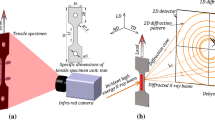Abstract
A strain reversal applied for both under hot and cold workings produces a microstructural transient which manifests in different ways and at different scales. The evolution of the dislocation network during strain reversal is the result of the competition between two mechanisms. The first mechanism corresponds to the partial untangling and recovery of previously created dislocation network and the second one is associated to the build-up compatible with the current deformation condition. This study proposes a phenomenological formulation based on an effective equivalent strain concept to describe, in a simple way, the several experimental manifestations of the microstructural transient at grain and intragranular scales and its effect on the static recrystallisation kinetics.











Similar content being viewed by others
References
Rauch EF, Schmitt JH (1989) Mater Sci Eng A 113:441
Kostryzhev AG, Strangwood M, Davis CL (2010) Metall Mater Trans A 41:1399
Helbert AL, Feaugas X, Clavel M (1996) Metall Trans A 27:3043
Zhonghua L, Haicheng G (1990) Metall Trans A 21:717
Yoshida K, Brenner R, Bacroix B, Bouvier S (2011) Mater Sci Eng A 528:1037
Hasegawa T, Yakou T, Kocks UF (1986) Mater Sci Eng 81:189
Mataya MC, Carr MJ, Krauss G (1983) Mater Sci Eng 57:205
Christodoulou N, Woo OT, MacEwen SR (1986) Acta Mater 8:1553
Nesterova EV, Bacroix B, Teodosiu C (2001) Mater Sci Eng A 309–310:495
Peeters B, Bacroix B, Teodosiu C, Van Houtte P, Aernoudt E (2001) Acta Mater 49:1621
López-Pedrosa M, Wynne BP, Rainforth WM (2006) J Microsc 222:97
Farag MM, Sellars CM, McG Tegart WJ (1968) Deformation under hot working conditions (Special Report No. 108). Iron Steel Institute, London, p 60
Zhu Q, Sellars CM (1997) In: McNelley TR (ed) Proceedings of Rex’96, the 3rd international conference on recrystallization and related phenomena, Monterey Institute of Advanced Studies, Monterey, California, USA, 1996, p 195
Hasegawa T, Yakou T, Karashima S (1975) Mater Sci Eng 20:267
Zhu Q, Sellars CM (2001) Scr Mater 45:41
Lindh E, Hutchinson B, Ueyama S (1993) Scripta Metall 29:347
Bartolomé R, Jorge-Badiola D, Astiazarán JI, Gutiérrez I (2003) Mater Sci Eng A 344:340
Embury JD, Poole WJ, Koken E (1992) Scr Mater 27:1465
McDonald DT, Bate PS, Hutchinson WB (2005) Mater Sci Technol 21:693
Jorge-Badiola D, Lanzagorta JL, Gutiérrez I (2011) Metall Mater Trans A 42:2633
Jorge-Badiola D, Gutiérrez I (2004) Acta Mater 52:333
Humphreys FJ (1999) J Microsc 195:170
Farag MM, Sellars CM, McG Tegart WJ (1968) Deformation under hot working conditions. Special Report No. 108, Iron and Steel Institute, London, p 60
Delannay L, Mishin OV, Juul-Jensen D, Van Houtte P (2001) Acta Mater 49:2441
Verbeken K, Kestens L (2002) Mater Sci Forum 408–412:559
Jorge-Badiola D, Iza-Mendia A, Gutiérrez I (2005) Mater Sci Eng A 394:445
Tóth LS, Estrin Y, Lapovok R, Gu C (2010) Acta Mater 58:1782
Feaugas X, Haddou H (2007) Phil Mag 87:989
Jorge-Badiola D, Iza-Mendia A, Gutiérrez I (2009) J Microsc 235:36
Jorge-Badiola D, Iza-Mendia A, Gutiérrez I (2007) J Microsc 228:373
He W, Ma W, Pantleon W (2008) Mater Sci Eng A 494:21
Yassar RS, Baird JC, Horstemeyer MF (2009) Mater Sci Eng A 517:286
Glez JCh, Driver JH (2003) Acta Mater 51:2989
Brewer LN, Field DP, Merriman CC (2009) In: Schwartz AJ et al (eds) Electron backscatter diffraction in materials science. Springer, Berlin, p 251
Calcagnotto M, Ponge D, Demir E, Raabe D (2010) Mater Sci Eng A 527:2738
Kamaya M, Wilkinson AJ, Titchmarsh JM (2006) Acta Mater 54:539
Allain-Bonasso N, Wagner F, Berbenni S, Field DP (2012) Mater Sci Eng A 548:56
Zhu Q, Sellars CM (2001) Scr Mater 45:41
Winther G, Huang X, Hansen N (2000) Acta Mater 48:2187
Pantleon W (2002) J Mater Res 17:2433
Winther G, Huang X, Godfrey A, Hansen N (2004) Acta Mater 52:4437
Cizek P, Wynne BP, Rainforth WM (2006) J Phys 26:331
Lee K, Reis ACC, Kim G, Kestens L (2005) J Appl Cryst 38:668
Mandal S, Bhaduri AK, Subramanya Sarma V (2011) J Mater Sci 46:275. doi:10.1007/s10853-010-4982-6
Sellars CM (1996) In: Hutchinson B et al (eds) Thermomechanical processing: theory, modelling and practice [TMP2]. ASM, Stockholm, p 35
Lefevre-Schlick F, Brechet Y, Zurob HS, Purdy G, Embury D (2009) Mater Sci Eng A 502:70
Bailey JE, Hirsch PB (1962) Proc R Soc A 267:11
Somani MC, Karjalainen LP (2005) Ironmak Steelmak 32:294
Karjalainen LP, Somani MC (2001) In: Gottstein G, Molodov DA (eds) Recrystallization and grain growth. Proceedings of the first joint international conference. Springer, Berlin, p 779
Hu W (2004) Phil Mag Lett 84:7
Acknowledgements
This work reports new developments made by the authors throughout research projects with a financial grant from the Research Fund for Coal and Steel of the European Community (RFCS-7210-PR/291 and RFSR-CT-2007-00014) and the CICYT (Spain) (MAT2001-4281-E) and from the Basque Government (S-PE05CE01).
Author information
Authors and Affiliations
Corresponding author
Appendix: Parametrisation study
Appendix: Parametrisation study
Present formulation of the effective equivalent strain needs two parameters, as it can be concluded from the whole set of equations from Eqs. (1–7). The first one is the λ parameter while the second one is the proportionality factor A connecting pre-strain and ε0. Aiming to analyse the effect of these two parameters on the equivalent effective strain predictions, two specific points on the εeff–εrev plot have been regarded: the minimum of ε eff (ε Arev , ε Aeff ) and the strain required to achieve the same equivalent strain as just before strain reversal ε Brev (ε eff = εpre), see Fig. 12a. The minimum of the equivalent effective strain during strain reversal must satisfy:
In Fig. 12b, c, the evolution in the position of the minimum ε Arev and its value ε Aeff has been plotted as a function of the λ parameter for three different A. From these plots several conclusions can be extracted. First, ε Arev strongly depends on the λ parameter for low λ values, whereas at larger values, εmin converges progressively irrespective of A. As A increases, the strain needed to reach the minimum shortens for any λ value. Interestingly, the effective equivalent strain evaluated at the minimum ε Aeff decreases monotonically with λ and it increases monotonically with A.
Concerning ε Brev (ε eff = εpre), the variation of this reverse strain with λ for two pre-strains and two A values has been plotted in Fig. 12d. ε Brev (ε eff = εpre) increases monotonically with the pre-strain and it diminishes with A for all λ. It is particularly meaningful that the ε Brev (ε eff = εpre) saturates at lower λ values as the pre-strain is enlarged. The application of different λ–A pairs for describing the experimental data reported in Ref. [6] are shown in Fig. 13. In this particular case, at the low reverse strain region λopt = 50 describes more accurately experimental data compared to λ = λopt/2 = 25 or λ = 2λopt = 100, whereas at large reverse strains, \( A \ne 0 \) yields larger deviations from experimental data than \( A = 0 \).
Application of the different λ–A in εeff for measuring dislocation densities through Eq. (10). Assessment of the applicability of the present formulation
In order to generalise this formulation to other hot working conditions, the variation in the pre-strain and/or the changes in the Zener–Hollomon parameter must be taken into account. In this line, further ongoing work is being undertaken.
Rights and permissions
About this article
Cite this article
Jorge-Badiola, D., Lanzagorta, J.L. & Gutiérrez, I. Discussion on the microstructural transients during strain reversal based on the effective equivalent strain concept. J Mater Sci 48, 1480–1491 (2013). https://doi.org/10.1007/s10853-012-6903-3
Received:
Accepted:
Published:
Issue Date:
DOI: https://doi.org/10.1007/s10853-012-6903-3






